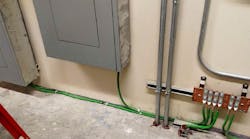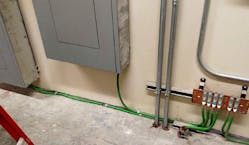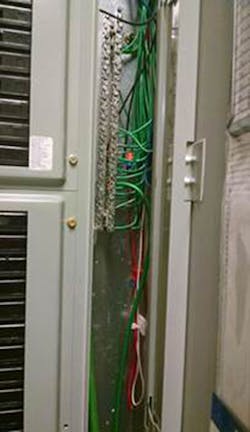Article 250 of the National Electrical Code (NFPA 70) addresses grounding and bonding requirements for electrical installations — addressing topics ranging from bonding jumpers to grounding of electrical equipment to ungrounded systems and even a section on how to prevent “objectionable currents.” What this Article doesn’t address is the specific requirement in health care facilities for bonding of panelboards in patient care vicinities. This requirement is above and beyond the requirements identified in Art. 250.
Section 517.14 [Panelboard Bonding] of the National Electrical Code (NEC) is one of the unique requirements for a health care facility. It’s been in the NEC for quite a while — at least for the duration of my career. This rule is intended to addresses the risk of creating a potential difference between panelboards that could put a patient at risk for electric shock. Most health care facilities are served by multiple branches of power, and the Code is pretty clear regarding what branch and how many sources of each branch are required (or allowed) in patient care areas.
The exact verbiage from the brand spanking new 2017 NEC is as follows:
“517.14 Panelboard Bonding. The equipment grounding terminal buses of the normal and essential branch-circuit panelboards serving the same individual patient care vicinity shall be connected together with an insulated continuous copper conductor not smaller than 10 AWG. Where two or more panelboards serving the same individual patient care vicinity are served from separate transfer switches on the essential electrical system, the equipment grounding terminal buses of those panelboards shall be connected together with an insulated continuous copper conductor not smaller than 10 AWG. This conductor shall be permitted to be broken in order to terminate on the equipment grounding terminal bus in each panelboard.”
The additional requirement for a health care facility is that the grounding terminal buses are directly connected (bonded) together for normal and essential systems’ panelboards. The only exception to the direct connection requirement is that the conductor can be “broken” when the wire is terminated on the bus. This does not mean you can connect the No. 10 AWG conductors from the grounding terminal bus of each panel to the bus bar in the room and then call it a day. This installation does not bond the panels together; it only provides them with a common ground, which does not meet the intent of the rule.
Where this installation gets a bit tricky is after one defines the health care vicinity and then identifies where the panelboards are located that serve that vicinity. (Note: Refer to one of my previous articles, “Words Matter,” for the general definition of patient vicinity — that in itself is a full article.) The tricky part is not just defining the vicinity but applying Sec. 517.14 requirements to the normal and essential branch-circuit panelboards that serve the area. Surgical suites, patient rooms, and emergency departments are pretty straightforward when assessing the patient vicinity and the sources of power serving the same vicinity. Where it becomes a bit more difficult is when you have situations (such as a fixed imaging suite) that may have a single essential systems receptacle or essential systems lighting where the switch is located within the patient vicinity. Or, another dilemma may be if you have a clinic that uses both normal and critical branch power. Because the essential systems needs are less demanding than in some other modalities and construction types, often the sources for the branch circuits in these areas may not all be in the same electrical room or closet — but they still need to comply with the bonding requirements of Sec. 517.14.
Panelboard bonding is something that is often missed by both designers and installers who are not as familiar with health care construction. Designers should be mindful of how devices and lighting are circuited, and installers should be aware of this additional health care requirement to assure a safe and compliant patient care environment.





